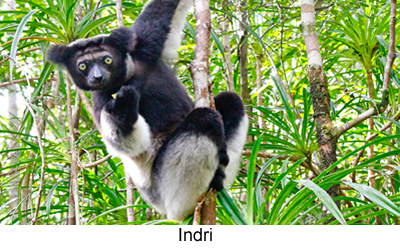 |
|
Name:
Indri (aka Babakoto) Classification:
Class: Mammalia
Order: Primates
Family: Indriidae
Genus: Indri
Species: I.
indri
Size: Body about
2-3 feet long, tail 0.15-0.20 feet long. Characteristics:
Status: Endangered The largest living species of lemur, the indri is special to the ecology as well as the culture of Madagascar. The tribal name given to the indri is Babakoto. Babakoto means "ancestor"; according to many legends the indri was involved in the creation of humans. In the 1700s, the Malagasy pointed out the Babakoto to European scientists and shout "Indri! Indri!" Indri means "Look over there!" Thus the indri got its modern name. Like most lemur species, indri family groups are dominated by a matriarch. The males are tasked with finding food under the charge of a ruling female. The family of 2-6 indri lives in an area of rainforest roughly 18 ha. Indris spend most of their time in the trees. They can climb and jump very far about the branches with ease. They eat various leaves, flowers and fruits, and occasionally leave the trees to eat soil. Unlike most lemur species, which are nocturnal, the indri is diurnal. They are famous for making loud, haunting calls through the jungle that can be heard from two miles away! Females will give birth to young in May or June. The young lemurs are able to move in the trees at about eight months, but will stay with their mother for two years. Indri only reproduce every two or three years and the females do not start reproducing until seven years. The indri is greatly threatened by habitat destruction as their trees are harvested for fuel, timber and slash-and-burn agriculture. It is largely considered taboo to eat an indri because of their cultural connection to the Malagasy ancestors. However, the indri has been largely hunted as a food source in the past and there are reports that they are still sometimes killed for food today. To help the indri and other lemurs, get in touch with these awesome organizations! Lemur Conservation Foundation-Dedicated
to preserving all lemurs, including the indri. The International Union
for Conservation of Nature, Lemur Projects-The ICUN has a plan to
protect the lemurs of Madagascar! Here are some indri videos: Legendary David Attenborough
meeting an indri face-to face: An indi getting a snack,
and the eerie calls his friends make: |
|
|
|
|
||
|
Contact
Us
|
||||
|
Taproot
Guru © ALL RIGHTS RESERVED
|
||||